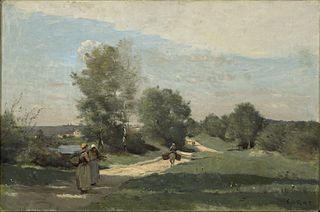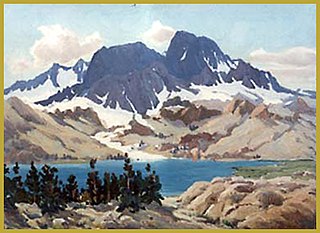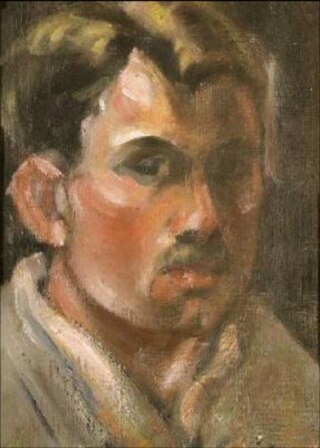
The Barbizon school of painters were part of an art movement toward Realism in art, which arose in the context of the dominant Romantic Movement of the time. The Barbizon school was active roughly from 1830 through 1870. It takes its name from the village of Barbizon, France, on the edge of the Forest of Fontainebleau, where many of the artists gathered. Most of their works were landscape painting, but several of them also painted landscapes with farmworkers, and genre scenes of village life. Some of the most prominent features of this school are its tonal qualities, color, loose brushwork, and softness of form.

Horatio Walker LL.D. was a Canadian painter. He worked in oils and watercolours, often depicting scenes of rural life in Canada. He was influenced by the Barbizon school.

Tyrus Wong was a Chinese-born American artist. He was a painter, animator, calligrapher, muralist, ceramicist, lithographer and kite maker, as well as a set designer and storyboard artist. One of the most-influential and celebrated Asian-American artists of the 20th century, Wong was also a film production illustrator, who worked for Disney and Warner Bros. He was a muralist for the Works Progress Administration (WPA), as well as a greeting card artist for Hallmark Cards. Most notably, he was the lead production illustrator on Disney's 1942 film Bambi, taking inspiration from Song dynasty art. He also served in the art department of many films, either as a set designer or storyboard artist, such as Rebel Without a Cause (1955), Around the World in 80 Days (1956), Rio Bravo (1959), The Music Man (1962), PT 109 (1963), The Great Race (1965), Harper (1966), The Green Berets (1968), and The Wild Bunch (1969), among others.

Millard Owen Sheets was an American artist, teacher, and architectural designer. He was one of the earliest of the California Scene Painting artists and helped define the art movement. Many of his large-scale building-mounted mosaics from the mid-20th century are still extant in Southern California. His paintings are in the Metropolitan Museum of Art and the Whitney Museum in New York, the Chicago Art Institute, the National Gallery in Washington D.C.; and the Los Angeles County Museum.

Mathias Joseph Alten was a German-American impressionist painter active in Grand Rapids, Michigan.

Theodore Nikolai Lukits was a Romanian American portrait and landscape painter. His initial fame came from his portraits of glamorous actresses of the silent film era, but since his death, his Asian-inspired works, figures drawn from Hispanic California and pastel landscapes have received greater attention.

Colin Campbell Cooper, Jr. was an American impressionist painter of architectural paintings, especially of skyscrapers in New York City, Philadelphia, and Chicago. An avid traveler, he was also known for his paintings of European and Asian landmarks, as well as natural landscapes, portraits, florals, and interiors. In addition to being a painter, he was also a teacher and writer. His first wife, Emma Lampert Cooper, was also a highly regarded painter.
Timothy J. Clark is an American artist best known for his large watercolor paintings of urban landscapes, still lifes, and interiors, and for his oil and watercolor portraits. His paintings and drawings are in the permanent collections of more than twenty art museums.
Robert Clunie was a Scottish-American plein air painter, specializing in California landscape art with a particular focus on the rugged mountain scenery of the High Sierra.

John Dwyer McLaughlin was an American abstract painter. Based primarily in California, he was a pioneer in minimalism and hard-edge painting. Considered one of the most significant Californian postwar artists, McLaughlin painted a focused body of geometric works that are completely devoid of any connection to everyday experience and objects, inspired by the Japanese notion of the void. He aimed to create paintings devoid of any object hood including but not limited to a gestures, representations and figuration. This led him to the rectangle. Leveraging a technique of layering rectangular bars on adjacent planes, McLaughlin creates works that provoke introspection and, consequently, a greater understanding of one's relationship to nature.
Peter Seitz Adams is an American artist. His body of work focuses on landscapes and seascapes created en plein air in oil or pastel as well as enigmatic figure and still-life paintings. He is noted for his colorful, high-key palette and broad brushwork. Adams has held numerous solo and group exhibitions in galleries and museums, including throughout California, the Western United States, and on the East Coast in Philadelphia, Vermont, and New York. Adams is the longest serving President of the California Art Club and has served on its board of directors in Pasadena, California from 1993 to 2018. He is also a writer on subjects relating to historic artists for the California Art Club Newsletter, as well as for a number of the organization's exhibition catalogs.

The terms California Impressionism and California Plein-Air Painting describe the large movement of 20th century artists who worked out of doors, directly from nature in California, United States. Their work became popular in the San Francisco Bay Area and Southern California in the first three decades after the turn of the 20th century. Considered to be a regional variation on American Impressionism, the California Impressionists are a subset of the California Plein-Air School.

Victor Stanley Matson (1895–1972) was an American artist representative of the California Plein-Air school of painting. He was active from the 1920s until his death. An active organizer for several Southern California arts organizations, he served as president of the historic California Art Club from 1961 to 1962. His work was widely exhibited with the Southland art clubs in an era when few galleries were interested in Plein-Air landscapes and he had a solo exhibition at Los Angeles City Hall in 1964.
Tonal Impressionism was an artistic style of "mood" paintings with simplified compositions, done in a limited range of colors, as with Tonalist works, but using the brighter, more chromatic palette of Impressionism. An exhibition titled "Tonal Impressionism" was curated by the art historian Harry Muir Kurtzworth for the Los Angeles Art Association Gallery at the Los Angeles Central Library in June 1937 with the works of a number of prominent California artists. In recent years, the term has also been used to describe a non-linear approach to painting where the subject is massed in with tonal values without the use of underdrawing.
California Tonalism was art movement that existed in California from circa 1890 to 1920. Tonalist are usually intimate works, painted with a limited palette. Tonalist paintings are softly expressive, suggestive rather than detailed, often depicting the landscape at twilight or evening, when there is an absence of contrast. Tonalist paintings could also be figurative, but in them, the figure was usually out of doors or in an interior in a low-key setting with little detail.

Rinaldo Cuneo, was an American artist known for his landscape paintings and murals. He was dubbed "the Painter of San Francisco".
Albert Clinton Conner was an American Impressionist painter who was an integral part of the Richmond Group of painters in the late 19th and early 20th centuries. After moving to California, Conner helped found The Painters' Club of Los Angeles in 1906, which lay the groundwork for the creation of the California Art Club three years later in 1909.
Rexford Elson Brandt was an American artist and educator. Much of his oeuvre consists of paintings inspired by the life and geography of the West Coast of the United States, particularly California. Brandt worked in multiple mediums including print making, oil painting and watercolor painting. He gained national recognition for his watercolor painting during the period from the mid-1930s to the 1990s. Early in his career he was associated with California Scene Painting but after World War II Brandt focused on complex, semi-abstract works. The depiction of the regenerative warmth of the sun was a central focus of his painting; he wrote that "Everyone has hang-ups, I suppose. Mine is sunshine. Not sunlight -- although I like to paint sunlight too."

Thomas Lorraine Hunt was a Canadian-American landscape painter of the 1920s and 30s, known especially for his dramatic use of color. His paintings are considered a transition from impressionism to modernism. His primary subjects were boats and harbors in which the colors and shapes on the canvas took precedence over the exactness of the objects. Hunt was active among the Southern California group of Impressionist plein air painters and a founding member of the Laguna Art Museum.
Astrid Preston is a Latvian-American artist, painter and writer born in Stockholm, Sweden. She lives in Santa Monica, California where she received a B.A. in English Literature from University of California, Los Angeles in 1967. She has had solo exhibitions in Laguna Art Museum, Saginaw Art Museum, Wichita Falls Museum, Ella Sharp Museum and Arts College International. Articles and reviews of her works have appeared in Los Angeles Times, Forbes, Art in America and Artforum. Her works are in the permanent collection of Laguna Art Museum Bakersfield Museum of Art, Los Angeles County Museum of Art, Orange County Museum of Art, Long Beach Museum of Art, Hammer Museum, McNay Art Museum, Oakland Museum of California and Nevada Museum of Art.













